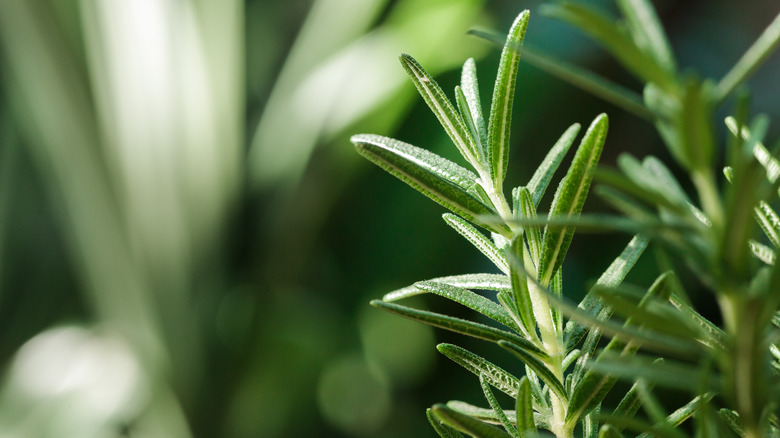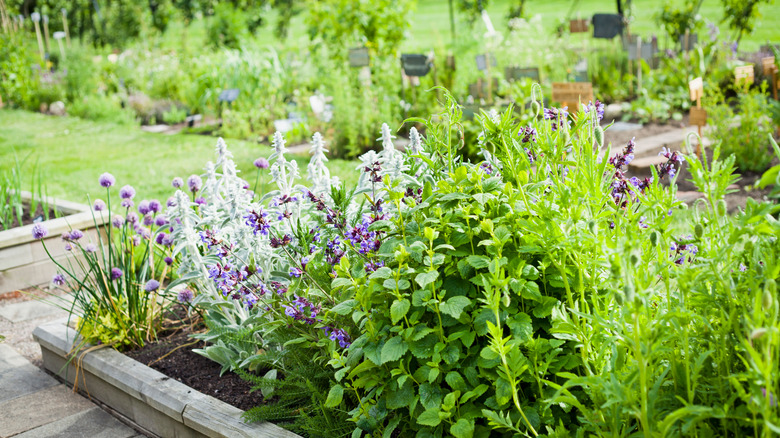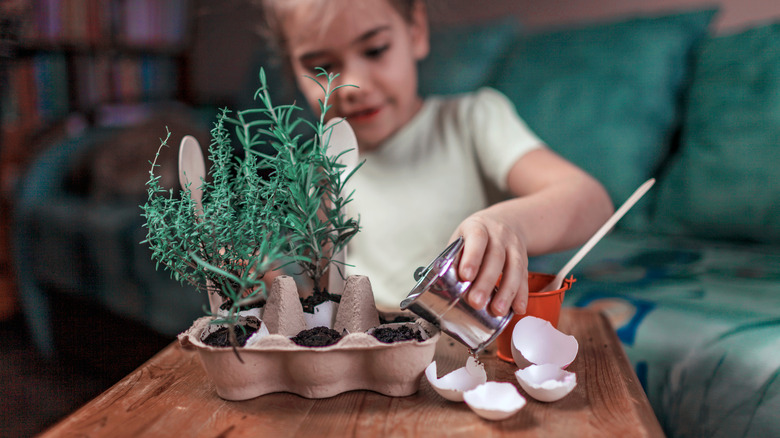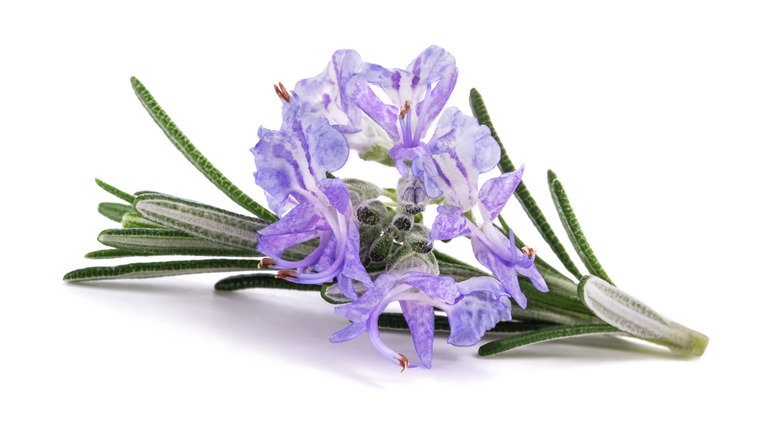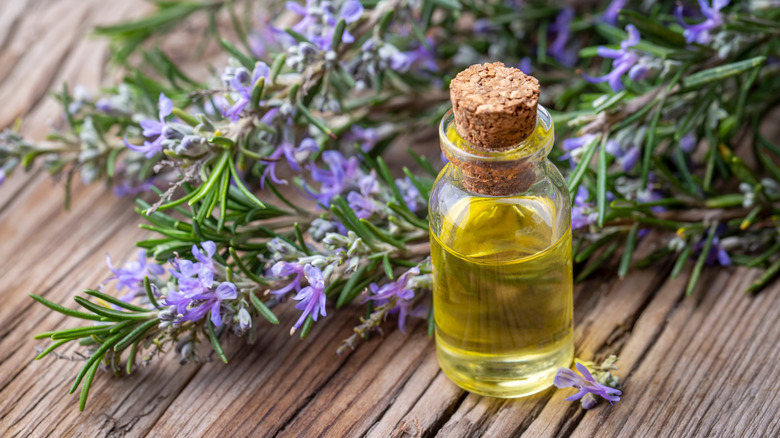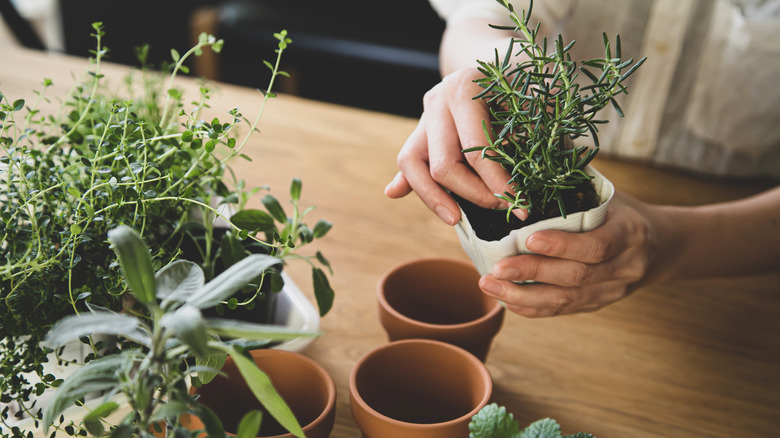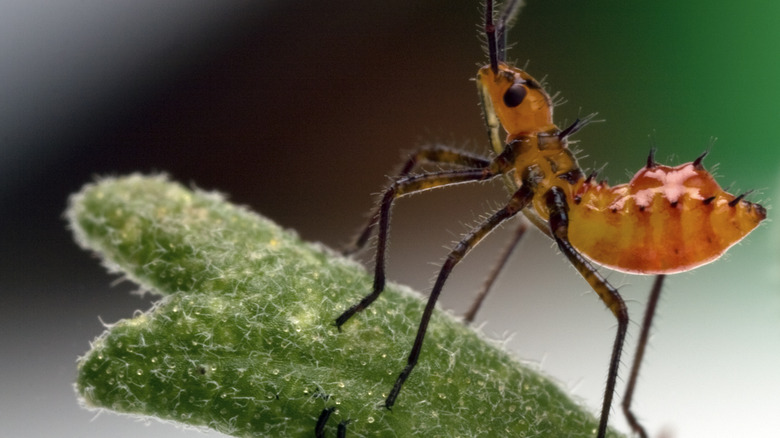How To Care For Your Rosemary Herb Plant
The rosemary herb plant, also known as Rosmarinus officinalis, is known for its sharp, stimulating smell used in essential oils to scent various hygiene products and flavor food. The Spruce explains that rosemary is a rather small plant that typically ranges between 2- to 6-feet tall and 2- to 4-feet wide. It has thin needle-like, evergreen leaves, similar to pine trees, that stand straight out from its thin woody trunk. Tiny flowers appear between the small green-grey leaves throughout the spring and summer seasons, in varying hues between white and blue.
Rosemary is a relatively easy plant to add to your garden for both color and fragrance. Herb Society states that rosemary originated from the dry and rocky part of the Mediterranean and has been in use since the time of the Ancient Greeks and Romans. The herb quickly became an icon as Shakespeare used it in the heart of many of his poems and symbolically represented happiness, loyalty, and love in the hands of a bride or the deceased. If you're looking to add a new touch to your garden with this colorful, fragmented herb, here's everything you need to know to grow and successfully maintain your rosemary herb plant.
How to use rosemary in the garden
As mentioned before, rosemary is a very fragranced plant. The aroma is said to be very stimulating to your brain and body and is known for improving brain functions, relieving pain, decreasing stress, and more (per Healthline). In addition, when planted around a comfortable sitting area, rosemary can influence a healthy and relaxing environment to enjoy alone or with guests. Watters Garden Center further shows that rosemary pieces from your garden can also easily be brought into your kitchen to add extra flavor to your meats and stews or freshen up a drink of choice.
In a garden environment, rosemary works great for landscaping because it is easy to maintain and requires little water to survive. Climbing varieties can even be used to decorate blank spaces on a wall or a trellis. Suppose you need a little extra color and fragrance on your porch or balcony. In that case, rosemary is also known for thriving beautifully in pots, especially when placed in areas where they receive plenty of sunshine throughout the day.
How to grow rosemary
Rosemary can easily propagate from a seed or a simple cutting. When starting a rosemary seed, MasterClass recommends establishing it indoors for the best results. The process is rather slow; therefore, start the process at least six months prior to its growing season and prepare to be patient. Get on the germination process by filling an egg carton, or seed starting tray, with a seed-starting mixture. Then, moisten the soil, sprinkle the seeds on top, and cover them with a little more of the seed starting mixture, then water again lightly before wrapping the tray in plastic wrap to retain moisture. Place in a warm and sunny position and wait a couple of weeks for the germination process to begin. Once the seeds germinate and emerge from the soil, place the seed tray in shallow water to speed up the growing process. As soon as the plants reach between 3 to 6 inches tall, they can be introduced to their outdoor environment.
When starting a rosemary plant from a cutting, Homestead Gardens suggests cutting 4 and 6 inches off of a healthy branch when the blooming season has completed. Before planting the cutting, clear the bottom 2 inches from the leaves and dip it into a growth hormone. In moist, well-draining potting soil, roots should begin to develop within three or four weeks of planting. After about eight weeks, the roots should be mature enough to be introduced to their permanent outdoor environment.
How to care for rosemary
Gardening Know How mentions that rosemary is not a difficult plant to care for. When growing and planting rosemary, ensure it is planted in well-draining soil. The soil should also be slightly sandy to replicate the land near the Mediterranean. Rosemary prefers dryer soil than most average garden plants; therefore, avoid overwatering the plant. Don't, however, mistake plants that prefer dryer soil for desert plants. Rosemary still needs water to survive; therefore, water the plant regularly, but don't rewater the plant until the soil is completely dry.
Like most Mediterranean plants, rosemary thrives in the sunlight. Ideally, rosemary should be placed in a position where it will receive between six and eight hours of direct sunlight. Even if you are growing your rosemary plants indoors, they still need plenty of sun; therefore, ensure you place them in a window that receives the most sunlight. Likewise, rosemary prefers a somewhat warmer and humid environment. The plant's health tends to drop as the weather becomes cooler, causing extensive damage if the temperature drops below freezing. Suppose you live in a rather cooler environment. In that case, Gardening Know How recommends planting your rosemary in pots and bringing it inside your home when the weather becomes cool to help it survive and thrive.
Rosemary herb plant varieties
Better Homes & Gardens introduces a long list of rosemary herb plant varieties you can choose from when adding it to your garden. These varieties of rosemary (Rosmarinus officinalis) range in size, colors, and uses. Let's take a close look at a few of these cultivars.
- Arp rosemary is a shrub variety of rosemary, which stands a sturdy 3- to 5-feet tall and 2- to 3-feet wide.
- Tuscan Blue rosemary is known for its greenish-blue leaves that can easily be shaped to fit a variety of fun garden styles.
- Trailing or Prostratus rosemary grows in trails that slowly cover the ground around them in evergreen foliage and blue flowers during its blooming season.
- Gorizia rosemary bears beautiful light blue flowers and produces evergreen foliage with much wider leaves than an average rosemary plant.
- Golden or Aureus variegated rosemary has yellow flecks over its thin evergreen leaves and produces cute light blue flowers in the spring.
- Majorca Pink rosemary produces unique pinking purple flowers in the spring and summer.
Is rosemary toxic?
Despite its rather common bodily uses, Botanical Online states that ingesting or inhaling a high amount of rosemary can actually cause a slight toxic reaction. The essential oil that exists within rosemary is called camphor, which can cause stomach and intestine irritation, kidney damage, and other neurotoxic effects when inhaled in large amounts. Pregnant people should also be cautious and consume small amounts of the plant at once as it can be abortifacient. Although RxList notes the German Commission E has approved rosemary for dyspepsia, hypertension, alopecia, and rheumatism, it can have negative effects when ingested in large quantities.
Pet Keen also informs that rosemary can also cause stomach irritation for common household pets, like cats and dogs, if consumed in substantial amounts. Luckily, animals tend to keep their distance from this plant, rarely choosing to come into contact or take a bite of the plant. This is probably due to the intense fragrance the plant produces.
How to repot rosemary
When it comes to growing rosemary in a potted environment, prepare to repot your plant at least once a year as it continues to mature. When repotting, the plant should simply be transferred to a pot that is one size up from the size of its current container. Repotting should only be done in spring, when the weather is warm, to avoid extensive damage to the plant and allow it to recover before the colder seasons roll around again (per The Spruce).
When repotting rosemary, it's important to ensure the soil remains to the plant's liking. This means using a well-draining soil mixture in the new pot to keep the ground light while preventing moisture build-up underneath the surface. To transfer the rosemary, loosen the plant from its current pot and center it at the desired level in its new home. You can adjust the height by adding or taking away soil from the bottom of the new container. When the rosemary is in its desired position, finish by filling in the gaps with more soil and patting it down firmly to keep the plant in place.
Common pests
Rosemary is known for attracting a few different types of pests, per Hunker, including aphids, spittlebugs, and whiteflies. Spider mites may also become an issue if your rosemary is a potted indoor plant. These pests all damage the plant by sucking important juices out of the inside. This can cause areas of the plant to dry up, wilt, and eventually die.
Fortunately, you can easily get rid of these pests. Start by ensuring your plants are in healthy conditions or determine and adjust what they are lacking if they are not thriving as they are supposed to. Then, as soon as you notice pests on the surface of your plant, spray it down with a garden hose. You can also add insecticidal soap to your rosemary to eliminate pests after the plant has been effectively hosed down. Ensure the insecticidal soap is diluted before being sprayed on the plant and always follow the terms of use located on the back of the packaging before applying it.
